Baffled by baffles? Confused by shingles and layers? Here's your guide to the various construction techniques that keep down and synthetic insulation in the right places, and you warm in your sleeping bag.
There are a variety of methods, and specifics differ between bags and manufacturers, but most brands spell out construction information in their product descriptions.
For example, Sierra Designs uses both continuous and side baffle construction in different down bags, and shingled and offset layered construction in different synthetic bags. GoLite often uses six-inch stretch baffle spacing that is differentially cut and side block baffles to prevent down migration. Mountain Hardwear welds some of its baffles.
So, what does all of that mean?
Read on for explanations of the most common sleeping bag construction methods:
- Down Construction: Sewn-through and baffles
- Synthetic Construction: Layers and shingles
- Other Techniques: Differential cut, differential fill, welding
Down Construction Techniques
Sewn-Through
Sewn-through, also called stitch-through, is the simplest construction technique. In sewn-through the shell and liner are pinched and stitched directly together to join the two layers. There's no vertical baffle wall, though the individual channels of down are commonly referred to as baffles. Sewn-through construction creates colder spots at the seams, allowing heat to escape, so it's better for warm weather bags.
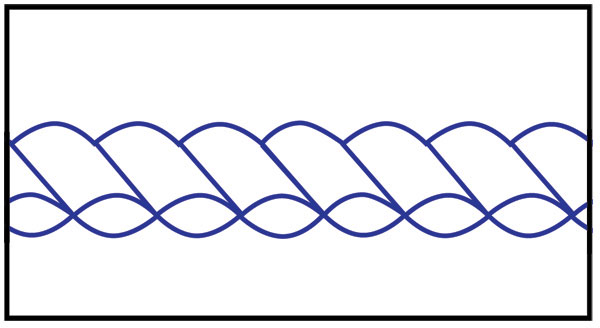
Baffles
Down bags are usually built with baffles, vertical walls of lightweight fabric or mesh that separate small quantities of down and keep it from shifting around. Though technically baffles are the dividing walls between the insulation, the individual channels or chambers are commonly referred to as the baffles too.
Here are examples of specific baffle techniques. Different techniques may be used in different areas of the same sleeping bag.
Box Baffles
Box baffles can be a simple box shape or slant or trapezoidal boxes, for better thermal efficiency. Box style baffles have an internal baffle wall and are warmer and heavier than sewn-through baffles. For even greater warmth, box baffles can be double layered on top of one another with their walls offset, like bricks, for less heat loss.
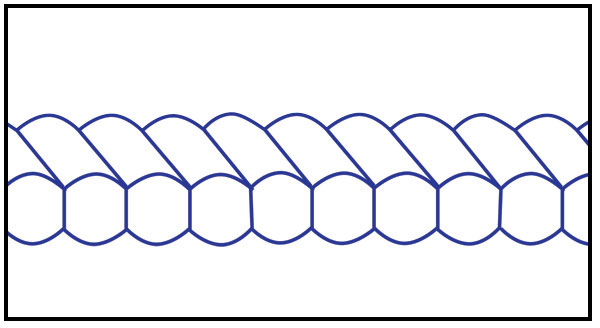 |
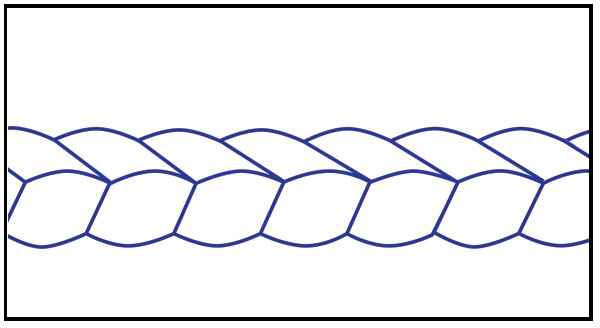 |
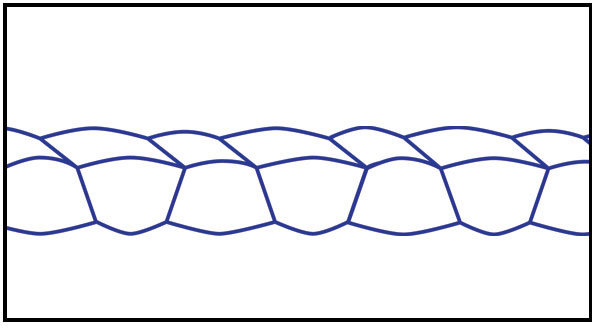 |
|
Box
|
Slant box | Trapezoidal box |
Continuous Baffles
Continuous baffles wrap all the way around the bag. They lack a side block baffle, allowing you to shift the down in the baffle chamber to adjust for a range of temperatures during warm weather and three-season use. When it's hot, lay the bag flat and move some down toward the bottom of your bag, so you have less insulation on top. When it's cooler, move the down back up the baffle chamber to the top of the bag for greater insulation.
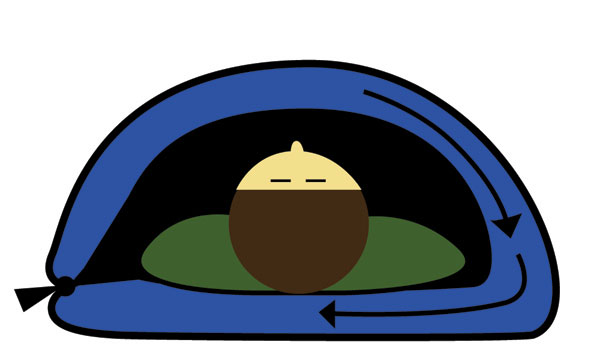
Continuous baffle
Side Block Baffles
Side block baffles act as a barrier to prevent down from migrating from the top of the bag to the bottom, especially in cold weather. Side block baffles are typically found on the side of the sleeping bag opposite the zipper. Differential fill bags use side block baffles to keep the distinct quantities of top and bottom insulation separated. A side baffle may be a straight side block baffle or a V-shape vertical side block baffle that creates another insulation chamber.
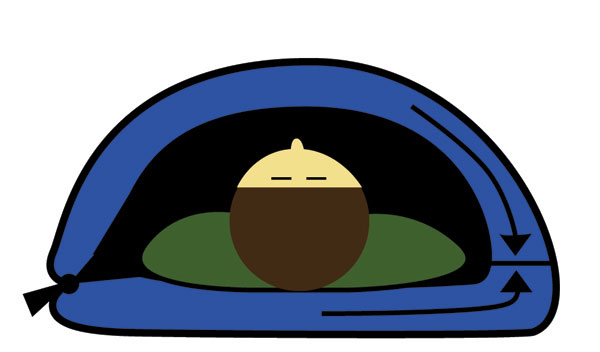 |
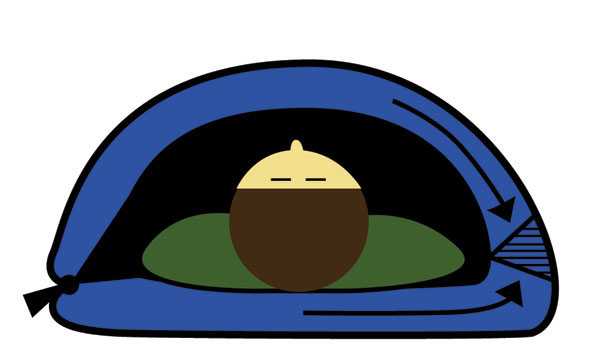 |
| Side block |
Vertical side block |
Stretch Baffles
Stretch baffles are a type of box baffle that uses stretchy, elastic materials to construct an expandable baffle chamber. This enables the bag to flex, stretch, and conform to the shape of the sleeper. Some claim that stretch baffles allow for the use of less insulation without a penalty in warmth.
V-Tube Baffles
V-tube baffles have baffle walls on a slant to form a series of V or triangular baffles. V-tube baffles have more baffles for the same amount of space as a box baffle and reduce down migration for better thermal efficiency. They may be slightly heavier, due to having relatively more baffle walls.
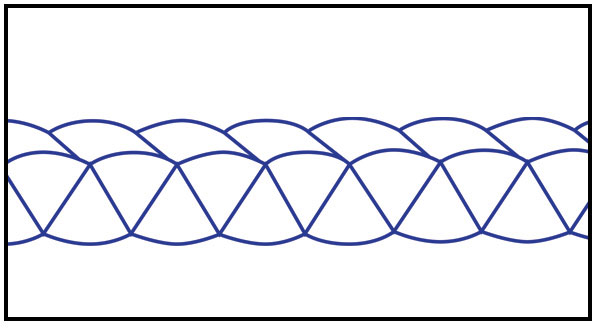
V-tube
Vertical Baffles
With vertical baffles the chambers of insulation run up and down the bag, instead of across the body. Down can't shift from the top to the bottom of the bag with vertical baffles. Vertical baffles may be used in the torso area only or from head to toe down the entire bag.
Synthetic Construction Techniques
Synthetic bags typically use a layers or shingles construction to hold insulation in place.
Layers/Blanket
Layers, or blanket, construction includes offset quilting and quilted-through layers.
Offset Quilt Layers
In offset quilt two layers, or more, of synthetic insulation are offset over each other. The top quilted layer is stitched to the outer shell and the bottom quilted layer is stitched to the inner lining. The sheets of insulation and the stitching are offset to avoid gaps where air could penetrate.
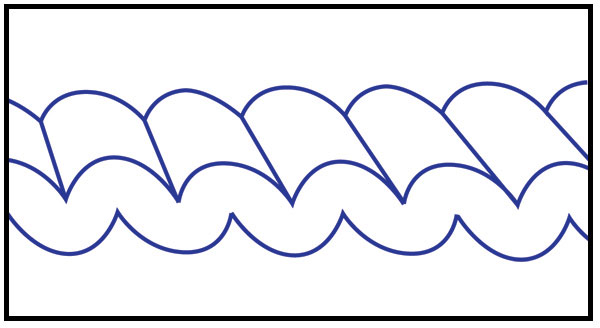
Offset quilt
Quilted-Through Layers
In the quilted-through layering method a sheet of insulation is cut to fit the shape of the bag. The sheet of insulation is sewn together with the shell and lining to hold the insulation in place. This simple construction method is similar to the sewn-through method for down. Quilted-through can create cold spots and is better for warm-weather bags.
Shingles
Shingles, or shingled, construction uses overlapping sheets or cut pieces of synthetic insulation that are stitched to the bag's shell and lining. Like shingles on a house, the pieces overlap each other, so there's less chance of a cold spot at any one point.

Shingles
Wave
Wave construction is a specific type of shingles construction. In wave construction a longer piece of shingled insulation (10 inches versus 7 inches, for example) is used in the same amount of space as regular shingles. The extra insulation in a compressed space is forced into a wave formation.

Wave
Other Construction Techniques
Differential Cut
Differential cut means that the inner lining of a sleeping bag is cut smaller than the outer shell fabric. This is because the inside of a bag has a smaller circumference than the outside of the bag. Differential cut can be used in bags with internal baffles. It allows the insulation to expand outward for better lofting and also reduces the chance of cold spots. Mummy bags are typically differentially cut. Some quilts are differentially cut. Rectangular bags are typically non-differentially cut.

Differential cut
Differential Fill
Bags with differential fill have more insulation on the top than on the bottom. The insulation on the bottom of the bag is compressed under your body weight, so it's less thermally efficient than the fully lofted insulation on top anyway. A down bag with differential fill may have 60 percent of its down on top and 40 percent on the bottom.

Differential fill
Welded Baffles
Welding fuses the baffle to the sleeping bag shell, instead of stitching through the fabric. Because welded seams lack puncture holes, manufacturers claim welded seams are stronger, more efficient, and (when used with a waterproof shell) completely waterproof to seal out moisture. Welded baffles may be offset, like other construction methods.
Additional reporting by Seth Levy and Alicia MacLeay; illustrations by Sarah Lampe

 by Heather Sable
by Heather Sable









